Assessment |
Biopsychology |
Comparative |
Cognitive |
Developmental |
Language |
Individual differences |
Personality |
Philosophy |
Social |
Methods |
Statistics |
Clinical |
Educational |
Industrial |
Professional items |
World psychology |
Animals · Animal ethology · Comparative psychology · Animal models · Outline · Index
| ?Dolphin
| ||||||||||||
|---|---|---|---|---|---|---|---|---|---|---|---|---|
| Bottlenose Dolphin breaching in the bow wave of a boat Bottlenose Dolphin breaching in the bow wave of a boat
| ||||||||||||
| Scientific classification | ||||||||||||
| ||||||||||||
|
See article below. |
Dolphins are aquatic mammals which are closely related to whales and porpoises. There are almost forty species of dolphin in seventeen genera. They vary in size from 1.2 metres (4 ft) and 40 kilograms (88 lb) (Maui's Dolphin), up to 9.5 m (30 ft) and ten tonnes (the Orca). They are found worldwide, mostly in the shallower seas of the continental shelves, and are carnivores, mostly eating fish and squid. The family Delphinidae is the largest in the Cetacea, and relatively recent: dolphins evolved about ten million years ago, during the Miocene. Dolphins are considered to be amongst the most intelligent of animals and their often friendly appearance and seemingly playful attitude have made them popular in human culture.
Origin of the name[]
The name is from Ancient Greek δελφίς delphis meaning "with a womb" which can be interpreted as meaning "a 'fish' with a womb".[1]
The word is used in a few different ways. It can mean:
- Any member of the family Delphinidae (oceanic dolphins),
- Any member of the families Delphinidae and Platanistoidea (oceanic and river dolphins),
- Any member of the suborder Odontoceti (toothed whales; these include the above families and some others),
- Used casually as a synonym for Bottlenose Dolphin, the most common and familiar species of dolphin.
In this article, the second definition is used. Porpoises (suborder Odontoceti, family Phocoenidae) are thus not dolphins in this sense. Orcas and some closely related species belong to the Delphinidae family and therefore qualify as dolphins, even though they are called whales in common language. A group of dolphins can be called a "school" or a "pod".
Taxonomy[]
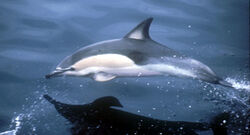
Common Dolphin
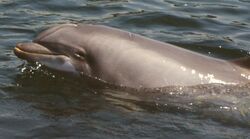
Bottlenose Dolphin
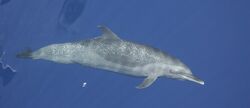
Spotted Dolphin
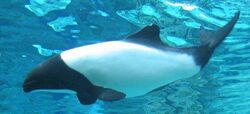
Commerson's Dolphin
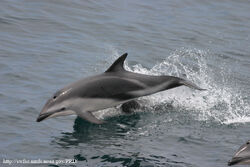
Dusky Dolphin
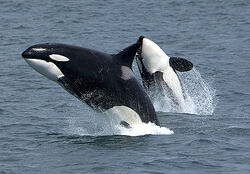
Killer Whales, also known as Orcas
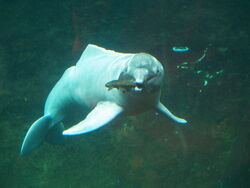
The Boto, or Amazon River Dolphin
- See also: List of dolphins
- Suborder Odontoceti, toothed whales
- Family Delphinidae, oceanic Dolphins
- Genus Delphinus
- Long-Beaked Common Dolphin, Delphinus capensis
- Short-Beaked Common Dolphin, Delphinus delphis
- Genus Tursiops
- Bottlenose Dolphin, Tursiops truncatus
- Indo-Pacific Bottlenose Dolphin, Tursiops aduncus
- Genus Lissodelphis
- Northern Rightwhale Dolphin, Lissodelphis borealis
- Southern Rightwhale Dolphin, Lissiodelphis peronii
- Genus Sotalia
- Tucuxi, Sotalia fluviatilis
- Genus Sousa
- Indo-Pacific Hump-backed Dolphin, Sousa chinensis
- Chinese White Dolphin (the Chinese variant), Sousa chinensis chinensis
- Atlantic Humpbacked Dolphin, Sousa teuszii
- Indo-Pacific Hump-backed Dolphin, Sousa chinensis
- Genus Stenella
- Atlantic Spotted Dolphin, Stenella frontalis
- Clymene Dolphin, Stenella clymene
- Pantropical Spotted Dolphin, Stenella attenuata
- Spinner Dolphin, Stenella longirostris
- Striped Dolphin, Stenella coeruleoalba
- Genus Steno
- Rough-Toothed Dolphin, Steno bredanensis
- Genus Cephalorynchus
- Chilean Dolphin, Cephalorhynchus eutropia
- Commerson's Dolphin, Cephalorhynchus commersonii
- Heaviside's Dolphin, Cephalorhynchus heavisidii
- Hector's Dolphin, Cephalorhynchus hectori
- Genus Grampus
- Risso's Dolphin, Grampus griseus
- Genus Lagenodelphis
- Fraser's Dolphin, Lagenodelphis hosei
- Genus Lagenorhyncus
- Atlantic White-Sided Dolphin, Lagenorhynchus acutus
- Dusky Dolphin, Lagenorhynchus obscurus
- Hourglass Dolphin, Lagenorhynchus cruciger
- Pacific White-Sided Dolphin, Lagenorhynchus obliquidens
- Peale's Dolphin, Lagenorhynchus australis
- White-Beaked Dolphin, Lagenorhynchus albirostris
- Genus Orcaella
- Australian Snubfin Dolphin, Orcaella heinsohni
- Irrawaddy Dolphin, Orcaella brevirostris
- Genus Peponocephala
- Melon-headed Whale, Peponocephala electra
- Genus Orcinus
- Killer Whale, Orcinus orca
- Genus Feresa
- Pygmy Killer Whale, Feresa attenuata
- Genus Pseudorca
- False Killer Whale, Pseudorca crassidens
- Genus Globicephala
- Long-finned Pilot Whale, Globicephala melas
- Short-finned Pilot Whale, Globicephala macrorhynchus
- Genus Delphinus
- Family Platanistoidea, River Dolphins
- Genus Inia
- Boto (Amazon River Dolphin), Inia geoffrensis
- Genus Lipotes
- Chinese River Dolphin (Baiji), Lipotes vexillifer
- Genus Platanista
- Ganges River Dolphin, Platanista gangetica
- Indus River Dolphin, Platanista minor
- Genus Pontoporia
- La Plata Dolphin (Franciscana), Pontoporia blainvillei
- Genus Inia
- Family Delphinidae, oceanic Dolphins
Six species in the family Delphinidae are commonly called "whales" but are strictly speaking dolphins. They are sometimes called "blackfish".
- Melon-headed Whale, Peponocephala electra
- Killer Whale, Orcinus orca
- Pygmy Killer Whale, Feresa attenuata
- False Killer Whale, Psudorca crassidens
- Long-finned Pilot Whale, Globicephala melas
- Short-finned Pilot Whale, Globicephala macrorhynchus
Hybrid dolphins[]
In 1933, three abnormal dolphins were beached off the Irish coast; these appeared to be hybrids between Risso's Dolphin and the Bottlenose Dolphin.[2] This mating has since been repeated in captivity and a hybrid calf was born. In captivity, a Bottlenose Dolphin and a Rough-toothed Dolphin produced hybrid offspring.[3] A Common-Bottlenose hybrid lives at SeaWorld California.[4] Various other dolphin hybrids have also been reported in the wild, such as a Bottlenose-Atlantic Spotted hybrid.[5] The best known hybrid however is the Wolphin, a False Killer Whale-Bottlenose Dolphin hybrid. The Wolphin is a fertile hybrid, and two such Wolphins currently live at the Sea Life Park in Hawaii, the first having been born in 1985 from a male False Killer Whale and a female Bottlenose. Wolphins have also been observed in the wild however.[6]
Evolution and anatomy[]
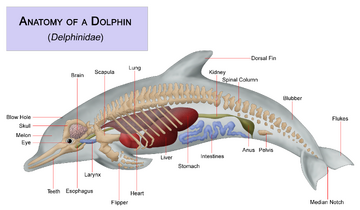
The Anatomy of a Dolphin showing its skeleton, major organs and body shape.
Evolution[]
- See also: Evolution of cetaceans
Dolphins, along with whales and porpoises, are thought to be descendants of terrestrial mammals, most likely of the Artiodactyl order. The ancestors of the modern day dolphins entered the water roughly fifty million years ago.
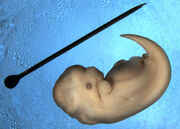
Hind Limb Buds on Dolphins An embryo of a Spotted Dolphin in the fifth week of development. The hind limbs are present as small bumps (hind limb buds) near the base of the tail. The pin is approximately 1 inch (~2,5 cm) long.
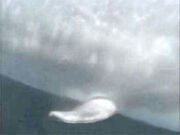
Bottlenose Dolphin with vestigial hind flippers, captured 2006 in Japan.
Modern dolphin skeletons have two small, rod-shaped pelvic bones thought to be vestigial hind legs. In October 2006 an unusual Bottlenose Dolphin was captured in Japan; it had small fins on each side of its genital slit which scientists believe to be a more pronounced development of these vestigial hind legs.[7]
Anatomy[]
Dolphins have a streamlined fusiform body, adapted for fast swimming. The basic colouration patterns are shades of grey with a light underside and a distinct dark cape on the back. It is often combined with lines and patches of different hue and contrast.
The head contains the melon, a round organ used for echolocation. In many species, the jaws are elongated, forming a distinct beak; for some species like the Bottlenose, there is a curved mouth which looks like a fixed smile. Teeth can be very numerous (up to two hundred and fifty) in several species. The dolphin brain is large and has a highly structured cortex, which often is referred to in discussions about their advanced intelligence.
Unlike most mammals, dolphins do not have hair, but they are born with a few hairs around the tip of their rostrum which they lose after some time, in some cases even before they are born. The only exception to this is the Boto river dolphin, which does have some small hairs on the rostrum.
Senses[]
Most dolphins have acute eyesight, both in and out of the water, and their sense of hearing is superior to that of humans. Though they have a small ear opening on each side of their head, it is believed that hearing underwater is also if not exclusively done with the lower jaw which conducts the sound vibrations to the middle ear via a fat-filled cavity in the lower jaw bone. Hearing is also used for echolocation, which seems to be an ability all dolphins have. Their teeth are arranged in a way that works as an array or antenna to receive the incoming sound and make it easier for them to pinpoint the exact location of an object.[8] The dolphin's sense of touch is also well-developed. However, dolphins lack an olfactory nerve and lobes and thus are believed to have no sense of smell,[9] but they can taste and do show preferences for certain kinds of fish. Since dolphins spend most of their time below the surface normally, just tasting the water could act in a manner analogous to a sense of smell.
Though most dolphins do not have any hair, they do still have hair follicles and it is believed these might still perform some sensory function, though it is unclear what exactly this may be.[10] The small hairs on the rostrum of the Boto river dolphin are believed to function as a tacticle sense however, possibly to compensate for the Boto's poor eyesight.[11]
Behaviour[]
Pacific White-Sided Dolphins breaching
Dolphins are often regarded as one of Earth's most intelligent animals, though it is hard to say just how intelligent dolphins are, as comparisons of species' relative intelligence are complicated by differences in sensory apparatus, response modes, and nature of cognition. Furthermore, the difficulty and expense of doing experimental work with large aquatics means that some tests which could meaningfully be done still have not been carried out, or have been carried out with inadequate sample size and methodology. Dolphin behaviour has been studied extensively by humans however, both in captivity and in the wild. See the cetacean intelligence article for more details.
Social behaviour[]
Dolphins are social, living in pods (also called "schools") of up to a dozen individuals. In places with a high abundance of food, pods can join temporarily, forming an aggregation called a superpod; such groupings may exceed a thousand dolphins. The individuals communicate using a variety of clicks, whistles and other vocalizations. They also use ultrasonic sounds for echolocation. Membership in pods is not rigid; interchange is common. However, the cetaceans can establish strong bonds between each other. This leads to them staying with injured or ill individuals for support.
In May 2005, researchers in Australia discovered a cultural aspect of dolphin behaviour: Some dolphins (Tursiops aduncus) teach their children to use tools. The dolphins break sponges off and cover their snouts with them thus protecting their snouts while foraging. This knowledge of how to use a tool is mostly transferred from mothers to daughters, unlike simian primates, where the knowledge is generally passed on to both sexes. The technology to use sponges as mouth protection is not genetically inherited but a taught behaviour.[12]
They are also willing to occasionally approach humans and playfully interact with them in the water. Dolphins have also been known to protect swimmers from sharks by swimming circles around them.[13]
Dolphins are one of the few animals other than humans known to mate for reasons other than reproduction. Male Bottlenose Dolphins are known to engage in sexual acts with other dolphin species, which is not always consensual, though the Bottlenose may also be submissive in such encounters.[14] Occasionally, dolphins will also show sexual behaviour towards humans.[15]
Dolphins are known to engage in acts of aggression towards each other. The older a male dolphin is, the more likely his body is covered with scars ranging in depth from teeth marks made by other dolphins. It is suggested that male dolphins engage in such acts of aggression for the same reasons as humans: disputes between companions or even competition for other females. Acts of aggression can become so intense that targeted dolphins are known to go into exile, leaving their communities as a result of losing a fight with other dolphins.
Male Bottlenose Dolphins have been known to engage in infanticide. Dolphins have also been known to kill porpoises for reasons which are not fully understood, as porpoises generally do not share the same fish diet as dolphins and are therefore not competitors for food supplies.[16]
Feeding[]
Individual species may employ a number of methods of hunting, but even within a species various feeding methods may be employed, some being used by only a single dolphin population. Fish and squid are the main source of food for most dolphin species, but the False Killer Whale and the Killer Whale also feed on other marine mammals.
One feeding method employed by many species is herding, where a pod will control a school of fish while individual members take turns plowing through the school, feeding. The tightly packed school of fish is commonly known as bait ball. Coralling is a method where fish are chased to shallow water where they are more easily captured. In South Carolina, the Atlantic Bottlenose Dolphin takes this one step further with what has become known as strand feeding, where the fish are driven onto mud banks and retrieved from there.[17] In some places, Orcas will also come up to the beach to capture seals. Some species also whack fish with their fluke, stunning them and sometimes sending fish clear out of the water.
Reports of cooperative human-dolphin fisheries date back to the ancient Roman author and natural philospher Pliny.[18] A modern human-dolphin fishery still takes place in Laguna, Santa Catarina, Brazil.[19]
Jumping and playing[]
Dolphins often leap above the water surface, sometimes performing acrobatic figures (e.g. the spinner dolphin). Scientists are not always quite certain about the purpose of this behaviour and the reason for it may vary, it could be to locate schools of fish by looking at above-water signs like feeding birds, they could be communicating to other dolphins to join a hunt, attempting to dislodge parasites, or simply doing it for fun. Play is a very important part of dolphins' lives, and they can often be observed playing with seaweed or play-fighting with other dolphins. They even harass other locals, like seabirds and turtles. Dolphins also seem to enjoy riding waves and frequently 'surf' coastal swells and the bow waves of boats.
Human-dolphin relationships[]
Mythology[]
- See also: Dolphins in mythology
Dolphins have long played a role in human culture. Dolphins are common in Greek mythology and there are many coins from the time which feature a man or boy riding on the back of a dolphin. The Ancient Greeks treated them with welcome; a ship spotting dolphins riding in their wake was considered a good omen for a smooth voyage. Dolphins also seem to have been important to the Minoans, judging by artistic evidence from the ruined palace at Knossos. In Hindu mythology, the Ganges River Dolphin is associated with Ganga, the deity of the Ganges river.
Therapy[]
Dolphins are used in animal-assisted therapy, to help with various psychological and neurological problems such as autism, depression, Down syndrome and various development problems, and has shown to be beneficial for the participants.[20]
Entertainment[]
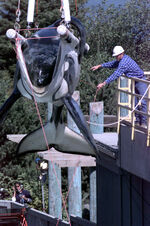
The famous Orca Keiko from the Free Willy movies being prepared for transport.
In more recent times, the 1963 Flipper movie and the subsequent popular Flipper television series, contributed to the popularity of dolphins in Western society. The series, created by Ivan Tors, portrayed a dolphin in a friendly relationship with two boys, Sandy and Bud; a kind of seagoing Lassie. Flipper, a Bottlenose Dolphin, understood English unusually well and was a marked hero. A second Flipper movie was made in 1996, which was based on the story of the original movie. A Bottlenose Dolphin also played a prominent role in the 1990s science fiction television series seaQuest DSV in which the animal, named Darwin, could communicate with English speakers using a vocoder, a fictional invention which translated the clicks and whistles to English and back.
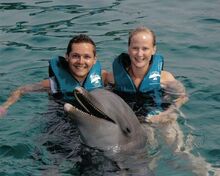
A young couple being entertained by a trained Bottlenose Dolphin in Puerto Plata, Dominican republic.
More well known from this time period is probably the movie Free Willy however, which made famous the Orca playing Willy, Keiko. The 1977 horror movie Orca paints a less friendly picture of the animal. Here, a male Orca takes revenge on fishermen after the killing of his mate. In the 1973 movie The Day of the Dolphin trained dolphins are kidnapped and made to perform a naval military assassination using explosives.
The renewed popularity of dolphins in the 1960s resulted in the appearance of many dolphinariums around the world, which have made dolphins accessible to the public. Though criticism and more strict animal welfare laws have forced many dolphinariums to close their doors, hundreds still exist around the world attracting large amount of visitors. In the United States, best known are the SeaWorld marine mammal parks, and their common Orca stage name Shamu, which they have trademarked, has become well known. Southwest Airlines, an American airline, has even painted three of their Boeing 737 aircraft in Shamu colours as an advertisement for the parks and have been flying with such a livery on various aircraft since 1988.
Occasionally, dolphins make an appearance in computer games. Best known is the Ecco the Dolphin game series. The games are named after their main character, Ecco, a young Bottlenose Dolphin. The Ecco the Dolphin games hinge on the idea that cetaceans are sapient beings and have their own underwater society.
A well known American National Football League (NFL) team is named the Miami Dolphins. Their logo depicts an aqua-coloured Bottlenose Dolphin wearing an American football helmet and jumping in front of a coral-coloured sunburst.
Military[]
A number of militaries have employed dolphins for various purposes from finding mines to rescuing lost or trapped humans. Such military dolphins, however, drew scrutiny during the Vietnam War when rumors circulated that dolphins were being trained to kill Vietnamese skin divers. Best known today is the U.S. Navy Marine Mammal Program.
Literature[]
Dolphins are also common in contemporary literature, especially science fiction novels. A military role for dolphins is found in William Gibson's short story Johnny Mnemonic, in which cyborg dolphins are used in war-time by the military to find submarines and, after the war, by a group of revolutionaries to decode encrypted information. Dolphins play a role as sentient patrollers of the sea enhanced with a deeper empathy toward humans in Anne McCaffrey's The Dragonriders of Pern series. More humorous is The Hitchhiker's Guide to the Galaxy, in which dolphins are the second most intelligent creatures on Earth (after mice, and followed by humans) and tried in vain to warn humans of the impending destruction of the planet. However, their behaviour was misinterpreted as playful acrobatics. Their story is told in So Long, and Thanks for All the Fish. Much more serious is their major role in David Brin's Uplift series. A talking Dolphin called "Howard" helps Hagbard Celine and his submarine crew fight the evil Illuminati in Robert Shea and Robert Anton Wilson's epic: Illuminatus Trilogy
Dolphins also appear frequently in non-science fiction literature however. In the book The Music of dolphins by author Karen Hesse, a girl is raised by dolphins from the age of four until she is discovered by the coast guard. Fantasy author Ken Grimwood wrote dolphins into his 1995 novel Into the Deep about a marine biologist struggling to crack the code of dolphin intelligence, including entire chapters written from the viewpoint of his dolphin characters. In this book, humans and dolphins are capable of communicating via telepathy.
Human threats to dolphins[]
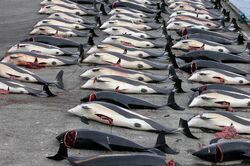
Dead Atlantic White-Sided Dolphins in Hvalba on the Faroe Islands, killed in a drive hunt.
Some dolphin species face an uncertain future, especially some of the river dolphin species such as the Amazon River dolphin, and the Ganges and Yangtze River dolphin, all of which are critically or seriously endangered. A 2006 survey found no individuals of the Yangtze River dolphin, leading to the conclusion that the species is now functionally extinct.[21]
Contamination of environment - the oceans, seas, and rivers - is an issue of concern, especially pesticides, heavy metals, plastics, and other industrial and agricultural pollutants which do not disintegrate rapidly in the environment are reducing dolphin populations, and resulting in dolphins building up unusually high levels of contaminants. Injuries or deaths due to collisions with boats, especially their propellers, are also common.
Various fishing methods, most notably purse seine fishing for tuna and the use of drift and gill nets, results in a large amounts of dolphins being killed inadvertently.[22] Accidental by-catch in trout nets is common and poses a risk for mainly local dolphin populations. In some parts of the world, such as some areas in Japan and the Faroe Islands, dolphins are traditionally considered as food, and killed in harpoon or drive hunts.
2007: Year of the Dolphin[]
The year 2007 has been declared as (International) Year of the Dolphin by the United Nations and United Nations Environment Programme (UNEP).[23] The idea was launched by the UN's Convention on Migratory Species and the Whale and Dolphin Conservation Society (WDCS).
References[]
- ↑ The American Heritage® Dictionary of the English Language, Fourth Edition, online entry at Dictionary.com, retrieved December 17 2006.
- ↑ Dolphin Safari (2006) sightings log, page retrieved December 17 2006.
- ↑ Texas Tech University (1997), Mammals of Texas - Rough-toothed Dolphin, article retrieved December 8 2006.
- ↑ Robin's Island Dolphins at SeaWorld California, page retrieved December 17 2006.
- ↑ Denise L. Herzing, Kelly Moewe and Barbara J. Brunnick (2003), Interspecies interactions between Atlantic spotted dolphins, Stenella frontalis and bottlenose dolphins, Tursiops truncatus, on Great Bahama Bank, Bahamas, article retrieved on December 17 2006.
- ↑ Louis Herman, interviewed for Associated Press, article by Jeanette J. Lee (2005), Livescience.com - Whale-Dolphin Hybrid Has Baby Wholphin, article retrieved April 26, 2007.
- ↑ Associated Press / FOX news (2006), Japanese Researchers Find Dolphin With 'Remains of Legs', article retrieved November 6 2006.
- ↑ Goodson, A.D. and M. Klinowska. "A Proposed Echolocation Receptor for the Bottlenose Dolphin (Tursiops truncatus): Modelling the Receive Directivity from Tooth and Lower Jaw Geometry", in Thomas and Kastelein, eds, NATO ASI Series A: Sensory Abilities of Cetaceans, vi.196:255-267 (Plenum NY, 1990) ISBN 0-30-643695-7
- ↑ SeaWorld, Bottlenose Dolphins - Senses, article retrieved December 17 2006.
- ↑ Bjorn Mauck, Ulf Eysel and Guide Dehnhardt (2000), Selective heating of vibrissal follicles in seals (Phoca Vitulina) and dolphins (Sotalia Fluviatilis Guianensis), article retrieved March 11, 2007.
- ↑ Laurie Stepanek (1998), Amazon River Dolphin (Inia geoffrensis), article retrieved March 11, 2007.
- ↑ Rowan Hooper for New Scientist (2005), Dolphins teach their children to use sponges, article retrieved December 17 2006.
- ↑ CBC News (2004), Dolphins save swimmers from shark, article retrieved March 11, 2007.
- ↑ National Geographic's Dolphins: The wild side documentary (1999), IMDb entry / National Geographic website entry
- ↑ Amy Samuels, Lars Bejder, Rochelle Constantine and Sonja Heinrich (2003), Marine Mammals: Fisheries, Tourism and Management Issues, chapter 15, pages 266 to 268, Cetaceans that are typically lonely and seek human company. Retrieved December 17 2006.
- ↑ Dr. George Johnson (date unknown), Is Flipper A Senseless Killer?, article retreived December 17 2006.
- ↑ "Coastal Stock(s) of Atlantic Bottlenose Dolphin: Status Review and Management," Proceedings and Recommendations from a Workshop held in Beaufort, North Carolina, 13-14 September 1993. U.S. Department of Commerce, National Oceanic and Atmospheric Administration, National Marine Fisheries Service. pp. 56-57.
- ↑ M.B. Santos, R. Fernández, A. López, J.A. Martínez and G.J. Pierce (2007), Variability in the diet of bottlenose dolphin, Tursiops truncatus, in Galician waters, north-western Spain, 1990–2005 (.pdf), article retrieved April 3, 2007.
- ↑ The Telegraph (2006), Brazil's sexiest secret, article retrieved March 11, 2007.
- ↑ Christian Antonioli and Michael A. Reveley, (2005), Randomised controlled trial of animal facilitated therapy with dolphins in the treatment of depression.
- ↑ Douglas Williams for Shanghai Daily (2006), Yangtze dolphin may be extinct. Article retrieved December 9 2006.
- ↑ Clover, Charles. 2004. The End of the Line: How overfishing is changing the world and what we eat. Ebury Press, London. ISBN 0-09-189780-7
- ↑ 2007: (International) Year of the Dolphin - Official website, website retrieved on January 14, 2007.
External links[]
. .
Further information:
- OM Place - pictorial comparative chart of various dolphin species.
- Dolphins and their significance in world mythology.
- Tursi's dolphin page
Dolphin conservation and research:
- The Whale & Dolphin Conservation Society (WDCS)
- Charityguide.com - Save Bottlenose dolphins
- The Dolphin Institute
- The Dolphin research center
- Digital Library of Dolphin Development, Cetacean origins, Thewissen Lab (Broken link)
Dolphin news:
Dolphin photos:
- Red Sea Spinner Dolphin - Photo gallery
- PBS NOVA: Dolphins: Close Encounters
- David's Dolphin Images
- Images of Wild Dolphins in the Red Sea
- National Geographic
| This page uses Creative Commons Licensed content from Wikipedia (view authors). |